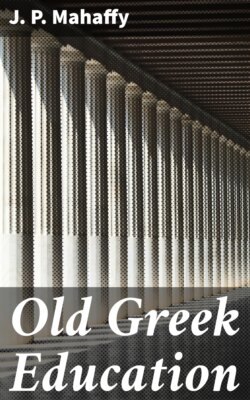Читать книгу Old Greek Education - J. P. Mahaffy - Страница 7
На сайте Литреса книга снята с продажи.
Footnote
ОглавлениеTable of Contents
[11] The exact relation of the ancient palæstra and the gymnasium has much exercised the critics. It seems plain that the former was a private establishment, and intended for boys; the latter more general, and resorted to by young men, not only amateurs and beginners, but also more accomplished athletes. Hence the terms are often confused. In the “Tract on the Athenian State,” however, the author mentions palæstras as built by the demos for its public use; and this tract, whoever may be its author, does not date later than 415 B.C.
[12] Herodotus, indeed (viii. 89), speaks of the generality of Greek sailors as able to swim.
[13] Paus. vi. 7, 9.
[14] It was a curious rule at the Olympic games that the competitors were even compelled to swear that they had spent a month in training at Elis, as if it mattered whether the victory was won by natural endowments only or by careful study. One would have thought that the importance of the contest would insure ample training in those who desired to win.
[15] I myself saw at the Olympic games now held at Athens, in the re-excavated stadion of Herodes, a sprint-race of two hundred yards over vine ground, cut into furrows, with dogs and people obstructing the course. Cf. Macmillan’s Magazine for September, 1876.
[16] Cf., for example, Grasberger, “Erziehung,” etc., iii. 212, quoting Cicero, “Tusc. Disp.,” ii. 23, 26.
[17] It is a perpetual and perhaps now ineradicable mistake, because we cannot see the real Athenians or Spartans of classical days, to imagine them in general like the ideal statues of the Greek artists. We find it even generally stated that beauty was the rule and ugliness the exception among them, in spite of Cicero’s complaint, when he was disillusioned by a visit to Athens: “Quotusquisque enim formosus est? Quum Athenis essem e gregibus epheborum vix singuli reperiebantur.”
